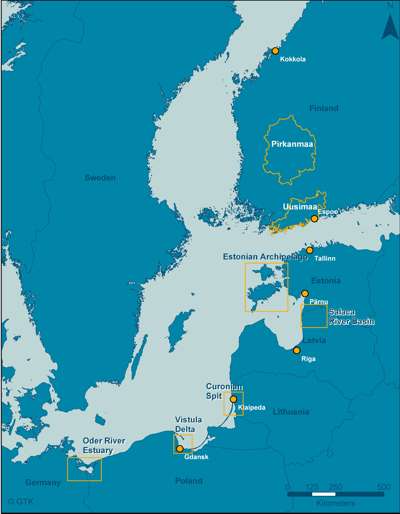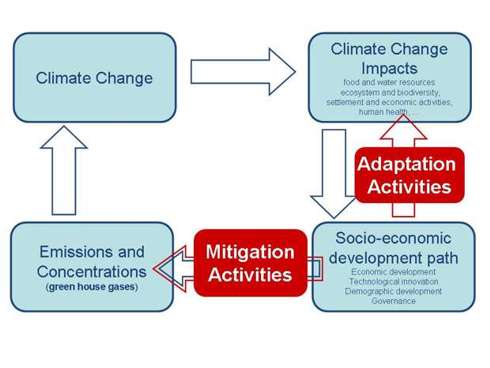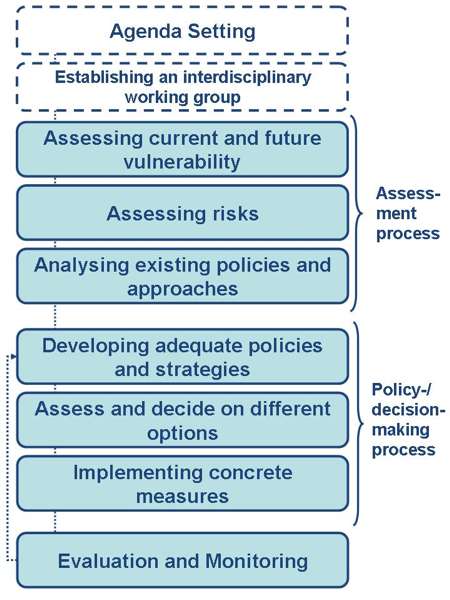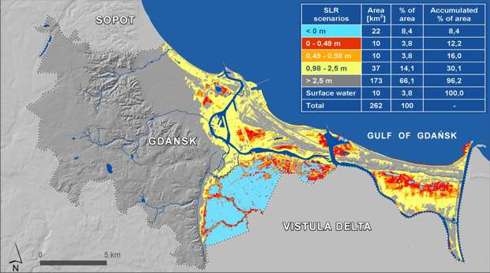
 Focusing on the Baltic Sea Region the project “ASTRA – Developing Policies and Adaptation Strategies to Climate Change in the Baltic Sea Region” assessed the regional impacts of climate change impacts and developed adequate adaptation strategies and policy recommendations together with relevant stakeholders. The ASTRA consortium consisted of research institutes, regional and local planning authorities around the Baltic Sea. The project has been co-financed by the European Regional Development Fund (ERDF) through the INTERREG IIIB Baltic Sea Programme from 2005-2007.
Focusing on the Baltic Sea Region the project “ASTRA – Developing Policies and Adaptation Strategies to Climate Change in the Baltic Sea Region” assessed the regional impacts of climate change impacts and developed adequate adaptation strategies and policy recommendations together with relevant stakeholders. The ASTRA consortium consisted of research institutes, regional and local planning authorities around the Baltic Sea. The project has been co-financed by the European Regional Development Fund (ERDF) through the INTERREG IIIB Baltic Sea Programme from 2005-2007.
The ASTRA project used climate change models and climate impact research to develop regional and local impact scenarios. In this context, it concentrated on risk awareness and the formulation of policy recommendations. The main focus was on practical applications; stakeholders became directly involved in the project’s activities.
 Climate change in the Baltic Sea Region
Climate change in the Baltic Sea Region
Scientific studies show a general trend to an average temperature rise and changes in precipitation patterns for the Baltic Sea Region (BSR). The BSR faces different regional and seasonal challenges in the light of a changing climate. Questions raised include what level of coastal protection is needed in the future, and how to cope with severe flooding events or water shortages. Regional and local assessments of climate change impacts have been carried out in case studies in participating countries. Figure 1 shows the participating countries and case studies of the ASTRA project.
Adaptation to climate change impacts
The concepts of adaptation and mitigation tackle climate change in two different ways as shown in figure 2. Adaptation seeks to moderate negative climate change impacts or exploits beneficial opportunities of climate changes, whereas mitigation includes measures and strategies to reduce CO2 and other greenhouse gas emissions. Due to the problematic economical and political nature of a global mitigation policy (Kyoto protocol), the ASTRA project has focused mainly on the adaptation side.
Both approaches should be regarded as complements. The more successfully both concepts are followed, the lower the risks for society due to climate change impacts will be.
Current adaptation policies in the BSR
Adaptation to climate change impacts is rather new on the political agenda in the Baltic Sea Region as well as in the European Union. An assessment conducted by ASTRA project partners showed that there are only a few national initiatives (Finland, Germany) or programmes in sectors such as coastal protection, flood protection or forestry.
Public authorities responsible for policy making play a key role when addressing climate change issues. Their decisions should be beneficial for the sustainability in territorial development and taking into account climate change issues. Adaptation should become an integral part of policies, ensuring a sustainable future development.
The findings of ASTRA about existing adaptation strategies focus on a number of sectors –namely forestry, coastal and flood protection. The sector of urban planning has been considered to be mentioned as a separate field of existing adaptation strategies. During the analysis it was concluded that most activities concern flooding problems in urban areas. Therefore it has been included in the section of flood protection. Another sector that has to be mentioned in connection to climate change impacts is disaster control or disaster management. Most countries should have laws, programs and concepts in relation to civil protection in case of disasters . Extreme weather events are covered by these national strategies.

The ASTRA partners tried to integrate different views and opinions by having conducted three international conferences involving altogether more than 200 stakeholders from the BSR. Nevertheless, the results reflect the main concerns of the ASTRA project partners – they might differ when extending the partnership to other regions in the BSR. In order to gain a comprehensive overview of existing adaptation approaches further areas such as the energy, transport, tourism or health sector need to be analyzed.
Results:
Development of Adaptation Strategies:
Recommendations for policy-makers
Public authorities, responsible for policy-making on behalf of the public welfare, play a key role when addressing climate change issues. Their decisions can benefit sustainability in territorial development. Adaptation to climate change is an issue that affects public as well as private interest.
1. Adaptation is a cross-cutting issue; therefore it has to be tackled by the whole society. Public authorities play a key role in addressing the complex issue of adaptation to climate change. In the form of a pull and push strategy they can influence behaviour and demand: information and communication activities raise public awareness and prepare the ground for political and private agency to act. Financial incentives or regulations as push-factors can enhance appropriate activities of private and public actors. Self-organisation and self-responsibility should be fostered so that climate change adaptation can be brought forward by a mix of top-down and bottom-up approaches.
 2. Integrate adaptation needs into policies: adaptation to climate change impacts should not be regarded as a separate topic. Different fields of policies should be checked to be “climate proof”. Examples are regional development plans that should consider future climate change impacts when preparing land for building or cost-benefit analyses of tourism infrastructure that take changing climate conditions into account when making investment decisions.
2. Integrate adaptation needs into policies: adaptation to climate change impacts should not be regarded as a separate topic. Different fields of policies should be checked to be “climate proof”. Examples are regional development plans that should consider future climate change impacts when preparing land for building or cost-benefit analyses of tourism infrastructure that take changing climate conditions into account when making investment decisions.
3. Development of adaptation strategies needs a step-wise approach: Figure 3 provides an overview of the most important steps. Analyses of current and future vulnerabilities and risks as well as of existing policies are the bases for the development of adequate adaptation strategies. Different options should be considered when developing adaptation strategies to identify the most appropriate solutions. Evaluation and monitoring activities should be provided to verify the efficiency of the measures taken and facilitate adjustments.
4. Adaptation and mitigation go hand in hand: policy-makers should aim at considering both approaches – adaptation and mitigation – in different fields of policies. Only if both concepts are followed can future climate change be moderated and inevitable impacts are tackled.
Public authorities need to be involved:
i. On EU-level : the European Union plays a key role in climate change adaptation by enhancing the system of structural funding and influencing the climate change policy in European member states.
ii. Baltic Sea Region: the Baltic Sea is a common natural resource, as its member states are connected by joint responsibilities and challenges. Neighbouring countries should join their forces in tackling climate change impacts. Activities at trans-national level could comprise the initiation of a communication platform enhancing the exchange of local, regional and national experiences or best practices. A further field are joint research activities by research institutes and universities in the BSR that establish information or monitoring on climate change impacts and develop innovative adaptation approaches.
iii. National level: climate change adaptation should be recognised as an important topic on the political agenda. At the national level the preconditions for adequate responses are laid in gaining an overview of most vulnerable sectors, regions and groups and setting lasting and powerful information channels, empowering individuals through legal frameworks and maintaining capable structures to enforce policy actions, and regulations (territorial development). It is important is to guide regional development so that the preconditions of sustainability are maintained.
iv. Regional and local level: regional and local actors have to adjust general guidelines to their local needs and implement adaptation strategies, while giving feedback about concrete adaptation demands to higher planning levels. As knowledge on climate change issues and adaptation activities still is not sufficiently at regional and local level, capacity building in form of information campaigns, participatory processes and local assessments on potential climate change impacts are of high relevance. Learning from extreme events experienced in different parts of the BSR may help to see the various risks involved and ways to overcome them. Past extreme events are a good starting point in considering local adaptation needs. Anticipating the risks in strategies and during planning stages already is economically viable and will save individual human suffering.
Climate change adaptation is a complex task that requires joint societal efforts. Therefore, it should be addressed both by public bodies and by private actors. The development of adaptation measures may become a new market for technological innovation.
At regional and local level, tasks concerning climate change adaptation include the adjustment of general guidelines to local needs and the implementation of adaptation measures. Tools and approaches to initiate local processes and for the development of adaptation strategies can be found in various adaptation policy frameworks. It is recommended that such a project should be designed as an open process that involves all affected and interested stakeholders.
Results from the case study areas
This section should give short examples from case studies showing the impacts on different sectors. For more information about the other case studies please consult the ASTRA web pages or the final publication.
Integrated Coastal Zone Management in the Oder Estuary
The European Union recommends the elaboration of Integrated Coastal Zone Management (ICZM) to enhance sustainable development in European coastal zone areas. One of the main general recommendations for the whole of Europe is to include climate change consequences into ICZM strategies.
A good example in the field of ICZM and the recognition of climate change adaptation can be found in the ICZM-Oder/Odra project, which was also a part of the ASTRA project. One research activity has been the assessment of the availability of public information on climate change impacts. The assessment’s conclusion was that the existing information is insufficient. The project therefore initiated a regional information campaign on climate change impacts. Maps are suitable instruments for communicating flood risks and raising awareness. Flood maps show prone areas at different flood heights from 0.5-1.5 m above sea level (see ). A follow-up activity, not included in the project activities, has been the elaboration of detailed maps for the purposes of coastal protection. Another example of ICZM in the project was evaluated for the Island of Saaremaa from the Estonian partners.

Flood protection
Flood Protection measures in Gdansk
Owing to its geographic location in the Vistula delta, Gdansk is considerably vulnerable to floods caused by intensive precipitation, high discharge of the Vistula River, storm surges and ice jams. In addition, parts of the city and its infrastructure are situated below sea level. As a result the city has developed a network of flood protection infrastructure facilities, i.e. dikes, ditches, culverts, sluices, pumping stations and storage reservoirs. Recurring flood events with severe impacts, i.e. in 2001, have led to analyses of existing flood protection policies as well as analyses of technical condition and modernisation of the existing flood protection infrastructure. Predicted water run-off in rivers, resulting from intensity of precipitation and considerable urbanisation of the area in the last 30 years, has been taken into account. For the Gdansk region a sea level rise scenario map has been produced in figure 4.
Similar maps have been produced for the cities of Riga, Tallinn and Pärnu. For the region of Uusimaa, Finland project partners have elaborated an atlas showing the flood prone areas along the coast.
Conclusions of the ASTRA project for climate change adaptation in the BSR
• Awareness-raising activities in relation to climate change adaptation still have to be continued; communication, education and professional training are key aspects.
• Vulnerability assessments regarding different sectors should be conducted at national, regional and local level in order to identify needs of adaptation.
• Cooperation across sectors, administrative levels and regions is required when developing adaptation strategies by involving both public and private stakeholders.
• Climate change should be mainstreamed into existing holistic cross-sector approaches like Integrated Coastal Zone Management (ICZM).
• Organisational structures should encourage learning processes and enhance the transfer of knowledge and information about climate change. These processes as well as cooperation among administrative levels are key aspects.
• The implementation of adaptation strategies and recommendations has to be secured, through monitoring structures. New technical options should be developed and pilot projects should be launched.
• Climate change adaptation should not only be regarded from the technical point of view but also in societal, economical and political terms. Adaptation and mitigation strategies should become integrated in everyday life (political and individual).
Outlook:
It is important to see adaptation to climate change as an opportunity for the society and economy. It is not helpful to scare the public with worst scenarios and a negative attitude towards climate change. The scientific community has the obligation to serve the society and provide new methods and tools to cope with climate change. Hopefully the ASTRA project could help to raise awareness about climate change adaptation and act as an example for further studies in climate change adaptation research for other regions. The consortium is planning a follow-up project to further develop the methodology and assess the impacts of climate change on the water sector of the Baltic Sea Region.
About the author:
Michael Staudt works for the Geological Survey of Finland (GTK) and was the project manager of the ASTRA project (Contact: [email protected]).
References:
Hilpert, K., Mannke, F., Schmidt-Thomé, P. (eds.) 2007: Towards Climate Change
Adaptation in the Baltic Sea Region, Final ASTRA publication, Geological Survey of Finland, Espoo
The ASTRA consortium, 2007: Towards Climate Change Adaptation in the Baltic Sea Region- Results form the Case Studies, Final Case study booklet, Geological Survey of Finland, Espoo
For more information:
Publications are available under www.astra-project.org or may be ordered from the Geological Survey of Finland publication sales. (http://en.gtk.fi/Geoinfo/Publications/Publicationsales.html)